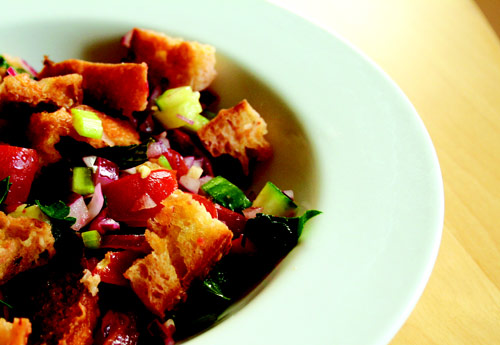
Harry Truman said it best, and I follow his advice to this day: I can’t stand the heat, so I stay out of the kitchen. Okay, so I go there periodically throughout the day to fill my water bottle, and of course to do some minor food prep for meals. But when the temperature rises, cooking is done outdoors or not at all. As far as I am concerned, my ovens take a vacation in August. With so many locally grown fruits and vegetables at their peak of perfection this month, however, none of my guests seem to notice.
Who could complain about a bowl of perfectly ripe raspberries, or a slab of juicy watermelon? Locally grown strawberries, plums, and grapes are as sweet as candy. What possible adornment could improve upon a fragrant, tree-ripened peach or nectarine? Veggies like organically-grown tomatoes, crunchy cucumbers, multi-color bell peppers, tender young green beans, and summer squash are often best after little or no cooking, with nothing more than a drizzle of extra virgin olive oil. Just a few minutes on the grill makes summer’s sweet corn the thing dreams are made of.
Thank thrifty Italians for this ingenious way of pairing summer vegetables with good, crusty bread that has gone stale. Panzanella is ideal for entertaining and potlucks this month, since it doesn’t require an oven and actually benefits from being made in advance. When tossed together, the vegetable juices blend with the fruity olive oil dressing and soften the chunks of dry bread. (In fact, in the Tuscan dialect panzanella translates to “little swamp”—a fitting description of the juice-soaked bread.)
Serve this as a light meal on a hot day, or as a side dish with grilled foods. And don’t skimp on the quality of the ingredients—especially the olive oil. Only the best will do. Fortunately everything is available at the August farmers’ market.
Farmers’ Market Panzanella
(Italian Bread Salad)When I lack the foresight to reserve bread for making this, I simply start with a fresh loaf. Cut the bread into thick slices and grill over indirect heat, turning several times, until well toasted but not necessarily charred, 5 to 10 minutes. When cool enough to handle, tear or cut into bite-size chunks.
2 tablespoons California red wine vinegar
1 garlic clove, crushed through a press
Salt
Freshly ground black pepper
1/2 cup California extra virgin olive oil
2 or 3 large vine-ripened tomatoes, cut into 3/4-inch dice, juices reserved
3/4 pound of 1- or 2-day-old Tuscan-style bread, torn into bite-size pieces or cut into 3/4-inch chunks (about 6 cups)
1 medium farm-fresh cucumber, halved lengthwise, seeded if desired, and cut crosswise into 1/2-inch slices
1 small red onion, thinly sliced
about 10 large fresh basil leaves, shredded or coarsely chopped*
In a large serving bowl, combine the vinegar, garlic, 1/4 teaspoon salt, and pepper to taste. Mix in the olive oil. Gently stir in the tomatoes and their juices.
Add the bread, cucumber, onion, and basil. Toss gently to moisten the bread. Cover with plastic wrap and let stand at cool room temperature for at least 30 minutes or as long as 2 hours to blend flavors. Bread will soften as it absorbs the dressing and vegetable juices. Taste, adding more salt and pepper if needed. Serves 4 to 6.
* For variation, substitute arugula, mint, or flat-leaf parsley for the basil.
Ten Slick Facts
The late food authority and writer Waverley Root observed that the type of fat in which food is cooked defines regional cuisine far more than any other ingredient used in a dish.
Some of the best food in the world comes from olive-growing regions—consider Provence in France, southern Italy, the Catalan section of Spain, and parts of Greece, the Middle East, and California.
During his extensive travels, Thomas Jefferson was so enamored with the taste of olive oil that he tried—unsuccessfully—to cultivate olive trees at his home in Virginia. Fortunately the Franciscans had better luck when they planted mission-variety olive trees in California.
California dominates the domestic olive oil industry, producing 850,000 gallons (worth about $17 million) in the 2009-2010 season.
There are 3 basic types of olive oil. From mildest flavor to most robust, those grades are pure, virgin, and extra virgin. Extra virgin oil comes from the first cold-pressing of olives. Cold-pressing preserves aromatic compounds and higher levels of antioxidants; and produces an oil that is relatively low in acid. (Pale-colored “lite” olive oil is not even a category—it is merely a way to sell flavorless, often chemically rectified oil. Contrary to what producers might have you believe, it is not lower in fat or calories.)
When it comes to fats, olive oil is considered a healthy choice thought to lower the risk of heart disease.
Most olive trees bear fruit only after 3 or 4 years. They reach full maturity at 8 to 10 years, and can continue to produce olives for centuries. (Yes, centuries.) Different varieties of olives ripen at different times.
Olive Arithmetic: It takes between 325 and 500 olives to yield 1 cup of oil.
One tablespoon of olive oil contains119 calories, no carbohydrates, and about 13.5g fat. An opened bottle of olive oil can be stored in a cool, dark place for up to 6 months.
Both here and abroad, high-quality olive oil is expensive to produce; and added freight costs make it even more so. When a producer sells olive oil directly to consumers at the farmers’ market, the “middle man,” has been eliminated and you are ensured the best price for a superior California oil.
The Danville Certified Farmers’ Market, located at Railroad and Prospect, is open every Saturday, rain or shine, from 9 a.m. until 1 p.m. For specific crop information call the Pacific Coast Farmers’ Market Association at 1-800-949-FARM or visit their web site at www.pcfma.com.
